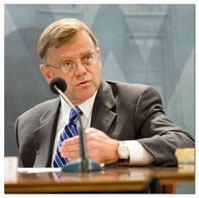Home > Press > FDA Nanotechnology Task Force Takes Positive Step Forward Agency Needs More Resources, Continued Transparency to Ensure Confidence in Safety
 |
Abstract:
STATEMENT BY MICHAEL R. TAYLOR
Former FDA Deputy Commissioner for Policy (1991-94)
FDA Nanotechnology Task Force Takes Positive Step Forward Agency Needs More Resources, Continued Transparency to Ensure Confidence in Safety
Washington, DC | Posted on July 25th, 2007Today's report from the Food and Drug Administration (FDA) Nanotechnology Task Force is an important and positive step forward in the agency's effort to tackle the new scientific and regulatory challenges posed by nanotechnology.
The Task Force is clear and candid in acknowledging the pervasive potential of nanotechnology to affect virtually every product category FDA regulates---from pharmaceuticals and devices to cosmetics and food supplements---and in calling for a wide range of FDA actions to prepare for and execute its oversight role. While available evidence does not suggest that all materials with nanoscale dimensions will be hazardous, the Task Force correctly concludes that the agency needs new safety assessment tools, greater nano-specific staff expertise and more risk research to assess the likelihood of long-term health effects from exposure to specific nanoscale materials.
The report also recognizes the need to gather more information from industry, especially to answer safety-related questions, and to provide companies with clear guidance so there can be reasonable and safe pathways to market for the many potential applications of nanotechnology under FDA's jurisdiction.
Equally important, the report signals FDA's commitment to a transparent public process for developing its regulatory policies. Public participation will be key both to developing good policies and winning public confidence in the agency's oversight of nanotechnology, and I applaud the Task Force and FDA for taking this approach.
Finally, the extensive nanotechnology "to do" list outlined in the report should remind Congress, as it considers FDA's 2008 budget, that it needs to fix the problem of FDA's chronic underfunding. The agency urgently needs more resources to do what needs to be done on nanotechnology--and do it urgently--along with the many other challenges the agency faces.
Michael R. Taylor is a research professor at the George Washington University School of Public Health and Health Services. In addition to serving as deputy commission for policy, he was an FDA staff lawyer and executive assistant to the FDA commissioner from 1976 to 1981. He is the author of a comprehensive report on FDA's "nano-readiness" commissioned by the Project on Emerging Nanotechnologies, "Regulating the Products of Nanotechnology: Does FDA Have the Tools Its Needs?" (October 2006); available at: http://www.nanotechproject.org
####
About The Project on Emerging Nanotechnologies
The Project on Emerging Nanotechnologies is an initiative launched by the Woodrow Wilson International Center for Scholars and The Pew Charitable Trusts in 2005. It is dedicated to helping business, government and the public anticipate and manage possible health and environmental implications of nanotechnology.
For more information, please click here
Contacts:
Sharon McCarter
202) 691-4016
Copyright © Woodrow Wilson International Center for Scholars
If you have a comment, please Contact us.Issuers of news releases, not 7th Wave, Inc. or Nanotechnology Now, are solely responsible for the accuracy of the content.
| Related News Press |
Govt.-Legislation/Regulation/Funding/Policy
![]() New imaging approach transforms study of bacterial biofilms August 8th, 2025
New imaging approach transforms study of bacterial biofilms August 8th, 2025
![]() Electrifying results shed light on graphene foam as a potential material for lab grown cartilage June 6th, 2025
Electrifying results shed light on graphene foam as a potential material for lab grown cartilage June 6th, 2025
![]() Institute for Nanoscience hosts annual proposal planning meeting May 16th, 2025
Institute for Nanoscience hosts annual proposal planning meeting May 16th, 2025
Announcements
![]() Rice membrane extracts lithium from brines with greater speed, less waste October 3rd, 2025
Rice membrane extracts lithium from brines with greater speed, less waste October 3rd, 2025
![]() Researchers develop molecular qubits that communicate at telecom frequencies October 3rd, 2025
Researchers develop molecular qubits that communicate at telecom frequencies October 3rd, 2025
![]() Next-generation quantum communication October 3rd, 2025
Next-generation quantum communication October 3rd, 2025
![]() "Nanoreactor" cage uses visible light for catalytic and ultra-selective cross-cycloadditions October 3rd, 2025
"Nanoreactor" cage uses visible light for catalytic and ultra-selective cross-cycloadditions October 3rd, 2025
Interviews/Book Reviews/Essays/Reports/Podcasts/Journals/White papers/Posters
![]() Spinel-type sulfide semiconductors to operate the next-generation LEDs and solar cells For solar-cell absorbers and green-LED source October 3rd, 2025
Spinel-type sulfide semiconductors to operate the next-generation LEDs and solar cells For solar-cell absorbers and green-LED source October 3rd, 2025
![]() Rice membrane extracts lithium from brines with greater speed, less waste October 3rd, 2025
Rice membrane extracts lithium from brines with greater speed, less waste October 3rd, 2025
|
|
||
|
|
||
| The latest news from around the world, FREE | ||
|
|
||
|
|
||
| Premium Products | ||
|
|
||
|
Only the news you want to read!
Learn More |
||
|
|
||
|
Full-service, expert consulting
Learn More |
||
|
|
||








